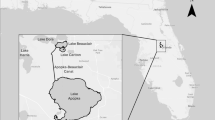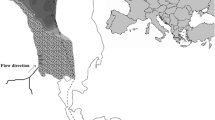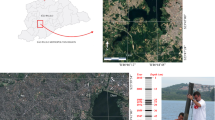Abstract
We present a ~ 40–year record of environmental change in the Swan Oxbow, Yangtze River, China, inferred from testate amoeba and sedimentary pigment data, combined with remote sensing and analysis of local socio–economic growth. These data indicate there were several distinct phases of aquatic conditions linked to human activities in the region: (1) Between ca. AD 1970 and 1984, there may have been some exchange of water and organic matter between the Swan Oxbow and the main river channel, following initial hydrologic disconnection in 1972. The lake area was relatively large in the early phase after the oxbow first formed, and the trophic state generally increased during that time frame, (2) From ca. AD 1984 to 1992, the lake area was about a third smaller in size, while the human population and GDP increased about 10% and 10x, respectively, compared to values in 1975. The nutrient status (inferred from testate amoeba and pigment data) increased, owing to the greater discharge of nutrients and separation of the Swan Oxbow from the main Yangtze River, which reduced water supply and increased sedimentation in the oxbow, (3) From ca. AD 1992 to 2003, the lake continued to diminish in size, to an area < 20 km2, except in 1998, when a major flood occurred. The testate amoeba and pigment data suggest that water quality had improved by that time, which probably reflects efforts to control agricultural and industrial activities, including establishment of two national reserves in 1992 and 1993, created to protect the rare Père David’s deer (Elaphurus davidianus) and the freshwater Baiji dolphin (Neophocaena phocaenoides asiaeorientalis), (4) From ca. AD 2003 to 2005, the water area remained relatively unchanged, owing to construction of a dam following the 1998 flood. Occurrence of testate amoeba species Difflugia biwae and D. tuberspinifera, however, indicates that water pollution and eutrophication had been controlled in Swan Oxbow. The Swan Oxbow yielded important information about the effects of environmental protection and restoration in the middle reaches of the Yangtze River.





Similar content being viewed by others
References
Appleby PG (2001) Chronostratigraphic techniques in recent sediments. In: Last WM, Smol JP (eds) Tracking environmental change using lake sediments. Basin analysis, coring, and chronological techniques. Kluwer Academic Publishers, The Netherlands, pp 171–205
Appleby PG, Nolan PJ, Gifford DW, Godfrey MJ, Oldfield F, Anderson NJ, Battarbee RW (1986) Pb-210 dating by low background gamma–counting. Hydrobiologia 143:21–27
Asioli A, Medioli FS, Patterson RT (1996) Thecamoebians as a tool for reconstruction of paleoenvironments in some Italian lakes in the foothills of the southern Alps (Orta, Varese and Candia). J Foraminifer Res 26:248–263
Beyens L, Meisterfeld R (2001) Protozoa: testate amoebae. In: Smol JP, Birks HJB, Last WM (eds) Tracking environmental change using lake sediments. Kluwer Academic Publishers, Dordrecht, pp 121–153
Brown RA, Pasternack GB (2014) Hydrologic and topographic variability modulate channel change in mountain rivers. J Hydrol 510:551–564
Chen ZY, Li F, Shen HT, Wang ZH (2001) Yangtze River of China: historical analysis of discharge variability and sediment flux. Geomorphol 41:77–91
Dearing JA, Yang X, Dong X, Zhang E, Chen X, Langdong PG, Zhang K, Zhang W, Dawson T (2012) Extending the timescale and range of ecosystem services through paleoenvironmental analyses, exemplified in the lower Yangtze basin. Proc Natl Acad Sci USA 109:E1111–E1120
Escobar J, Brenner M, Whitmore TJ, Kenney WF, Curtis JH (2008) Ecology of testate amoebae (thecamoebians) in subtropical Florida lakes. J Paleolimnol 40:715–731
Fisher A, Flood N, Danaher T (2016) Comparing Landsat water index methods for automated water classification in eastern Australia. Remote Sens Environ 175:167–182
Gu Y, Ge J, Huang J, Zhu J (2009) Climate change and human activity and its relationship with the Jianghan lakes over the past 20,000 years. Geological Press, Beijing, pp 246 (in Chinese)
Gu Y, Li K, Qin Y, Qi S, Ge J, Li W (2013) Impact of human activity on ecological environment of Jianghan Lake group in the historical period, central China. Earth Sci 38:133–144 (in Chinese)
He X, Luo J, Huang X, Zhai LNi, C, (1999) Studies on change law of nitrogen and phosphorus nutrition elements in Tian–e–zhou (Swan) Oxbow of the Yangtze River. Reserv Fisheries 0:54–55 (in Chinese)
Hickman M, Schweger CE (1991) Oscillaxanthin and myxoxanthophyll in two cores from Lake Wabamun, Alberta. J Paleolimnol 15:127–137
Jiang Y, Ni Z, Fan Q, Li L, Li Y, Zhou Y, Tan D, Luo H (2006) Fuzzy Synthetic Evaluation of Water Quality in Tian’e–Zhou and He–wa–wu Oxbows of the Yangtze River. Freshw Fish 36:16–20 (in Chinese)
Kawamura T (1918) Japanese freshwater biology. Syoukabou Tokyo Japan 113–115 (in Japanese)
Kliza DA, Schröder-Adams CJ (1999) Holocene thecamoebians in freshwater lakes on Bylot Island, Northwest Territories Canada. J Foraminifer Res 29:26–36
Kowalewska G (2005) Algal pigments in sediments as a measure of eutrophication in the Baltic environment. Quat Int 130:141–151
Li L, Lu X, Chen Z (2007) River channel change during the last 50 years in the middle Yangtze River, the Jianli reach. Geomorphol 85:185–196
Loakes KL, Kyves DB, Lamb HF, Schabitz F, Dee M, Tyler JJ, Mills K, McGowan S (2018) Late Quaternary climate change in the north-eastern highlands of Ethiopia: a high resolution 15,600 year diatom and pigment record from Lake Hayk. Quat Sci Rev 202:166–181
Lorenzen CJ (1967) Determination of chlorophyll in pheopigments spectrophotometric equations. Limnol Oceanogr 12:990–992
Mazei Y, Tsyganov AN (2006) Freshwater testate amoebae. KMK, Moscow
McCarthy FMG, Collins ES, McAndrews JH, Kerr HA, Scott DB, Medioli FS (1995) A comparison of postglacial Arcellacean (Thecamoebian) and pollen succession in Atlantic Canada, illustrating the potential of arcellaceans for palaeoclimatic reconstruction. J Paleontol 69:980–993
McGowan S (2013) Pigment studies. In: Elias SA (ed) The encyclopedia of quaternary science, vol 3. Elsevier, Amsterdam, pp 326–338
Medioli FS, Scott DB (1988) Lacustrine thecamoebians (mainly Arcellaceans) as potential tools for palaeolimnological interpretations. Palaegeogr Palaeoclimatol Paleoecol 62:361–386
Mitchell EAD, Charman DJ, Warner BG (2008) Testate amoebae analysis in ecological and paleoecological studies of wetlands: past, present and future. Biodivers Conserv 17:2115–2137
Nara F, Tani Y, Soma Y, Soma M, Naraoka H, Watanabe T, Horiuchi K, Kawai T, Oda T, Nakamura T (2005) Response of phytoplankton productivity to climate change recorded by sedimentary photosynthetic pigments in Lake Hovsgol (Mongolia) for the last 23,000 years. Quat Int 136:71–81
Nasser NA, Patterson RT, Roe HM, Galloway JM, Falck H, Palmer MJ, Spence C, Sanei H, Macumber AL, Neville LA (2016) Lacustrine Arcellinina (testate amoebae) as bioindicators of arsenic contamination. Microb Ecol 72:130–149
Nasser NA, Patterson PT, Roe RM, Galloway JM, Falck H, Sanei H (2020) Use of Arcellinida (testate lobose amoebae) arsenic tolerance limits as a novel tool for biomonitoring arsenic contamination in lakes. Ecol Indic 113:106177
Ogden CG (1983) Observations on the systematics of the genus Difflugia in Britain (Rhizopoda, Protozoa). Bull Br Mus Nat Hist (Zool) 44:1–73
Pan BZ, Wang HJ, Liang XM (2008) Macrozoobenthos in Yangtze oxbows: community characteristics and causes of resources decline. J Lake Sci 20:806–813 (in Chinese)
Patterson RT, Roe HM, Swindles GT (2012) Development of an Arcellacean (testate lobose amoebae) based transfer function for sedimentary phosphorous in lakes. Palaeogeogr Palaeoclimatol Palaeoecol 348–349:32–44
Patterson RT, Kumar A (2002) A review of current testate rhizopod (“thecamoebian”) research in Canada. Palaeogeogr Palaeoclimatol Palaeoecol 180:225–251
Patterson RT, MacKinnon KD, Scott DB, Medioli FS (1985) Arcellaceans (Thecamoebians) in small lakes of New Brunswick and Nova Scotia: modern distribution and Holocene stratigraphic changes. J Foram Res 15:114–137
Peng A, Qiu H, Wang Y, Tang Z, Yang M, Gu Y (2006) Environment significance of Swan Lake in Hubei from pigment record. J Jianghan Univ (Nat Sci) 34:27–30 (in Chinese)
Qin Y, Gu Y, Xie S, Zhou X (2007) The environmental change over the last 30 years in Swan Oxbow of the Yangtze River China: evidence from testate amoebae. Geol Sci Technol Inf 26:37–42 (in Chinese)
Qin Y, Fournier B, Lara E, Gu Y, Wang H, Cui Y, Zhang X, Mitchell EAD (2013) Relationships between testate amoeba communities and water quality in Lake Donghu, a large alkaline lake in Wuhan, China. Front Earth Sci 7:182–190
Qin Y, Xie S, Smith HG, Swindles GT, Gu Y (2011) Diversity, distribution and biogeography of testate amoebae in China: implications for ecological studies in Asia. Eur J Protistol 47:1–9
Qin Y, Booth RK, Gu Y, Wang Y, Xie S (2009) Testate amoebae as indicators of 20th century environmental change in Lake Zhangdu, China. Fundam Appl Limnol 175:29–38
Qin Y, Payne R, Yang X, Yao M, Xue J, Gu Y, Xie S (2016) Testate amoebae as indicators of water quality and contamination in shallow lakes of the Middle and Lower Yangtze Plain. Environ Earth Sci 75:1–11
Reinhardt EG, Dalby AP, Kumar A, Patterson RT (1998) Arcellaceans as pollution indicators in mine tailing contaminated lake near Cobalt, Ontario, Canada. Micropaleontol 44:131–148
Rhoads BL, Lewis QW, Andresen W (2016) Historical changes in channel network extent and channel planform in an intensively managed landscape: natural versus human–induced effects. Geomorphol 252:17–31
Roe HM, Patterson RT (2014) Arcellacea (testate amoebae) as bio-indicators of road salt contamination in lakes. Microbial Ecol 68:299–313
Roe HM, Patterson RT, Swindles GT (2010) Controls on the contemporary distribution of lake thecamoebians (testate amoebae) within the Greater Toronto area and their potential as water quality indicators. J Paleolimnol 43:955–975
Roy S, Llewellyn CA, Egeland ES, Johnsen G (eds) (2011) Phytoplankton pigments characterization, chemotaxonomy and applications in oceanography. Cambridge University Press, Cambridge
Schönborn W (1984) Studies on remains of testacea in cores of the Great Woryty Lake (NE–Poland). Limnol 16:185–190
Scott DB, Medioli FS (1983) Agglutinated rhizopods in Lake Erie: modern distribution and stratigraphic implications. J Paleontol 54:809–820
Shen YF (1983) Protozoa of the Tibetan Plateau. In: Jiang XZ, Shen YF, Gong XJ (eds) Aquatic invertebrates of the Tibetan Plateau. Science Press, Beijing, pp 48–100 (in Chinese)
Steele RE, Nasser NA, Patterson RT, Gregory BRB, Roe HM, Reinhardt EG (2018) An assessment of sub-meter scale spatial variability of Arcellinida (Testate Lobose amoebae) assemblages in a temperate lake: implications for limnological studies. Microb Ecol 76:680–694
Swain B (1985) Measurement and interpretation of sedimentary pigments. Freshw Biol 15:53–75
Todorov M, Bankov N (2019) An atlas of Sphagnum-dwelling testate amoebae in Buogaria, Sofia, pp 1–286
Tsugeki N, Oda H, Urabe J (2003) Fluctuation of the zooplankton community in Lake Biwa during the 20th century: a paleolimnological analysis. Limnol 4:101–107
Wu J, Zhou Q, Xu D, Gong C, Wu Z, He F (2017) Progress in studies on water ecology in Tian’E Zhou oxbow. Acta Hydrobiol Sinica 41:935–946 (In Chinese)
Xie S, Evershed EP, Huang X, Zhu Z, Pancost RD, Meyers PA, Gong L, Hu C, Huang J, Zhang S (2013) Concordant monsoon–driven postglacial hydrological changes in peat and stalagmite records and their impacts on prehistoric cultures in central China. Geology 41:827–830
Yang J, Benyens L, Shen YF, Feng WS (2004) Redescription of Difflugia tuberspinifera Hu, Shen, Gu et Gong, 1997 (Protozoa: Rhizopoda: Arcellinida: Difflugiidae) from China. Acta Protozool 43:281–289
Yang J, Shen YF (2005) Morphology, biometry and distribution of Difflugia biwae Kawamura, 1918 (Protozoa: Rhizopoda). Acta Protozool 44:103–111
Yang J, Chen PX (1996) Movement and behavior of finless porpoise (Neophocaena phocaenoides Cuvier) at Swan Oxbow, Hubei Province. J Acta Hydrobiol Sinica 20:32–40
Zhang Y, Qi S, Yang D, Zhang K, Su Q, Gong X, Wu C (2009) High resolution sedimentary record of organochlorine pesticides in Sediment Cores from Tian’ezhou Oxbow. Saf Environ Eng 16:9–13
Zhu J, Wang LM, Lei G, Liao GC, Wu HY, Shen LP (2005) Reconnect the lake and river, protect wetland Zhangdu. Yangtze River 36:60–62 (in Chinese)
Zou DQ (1992) County annals of Xinzhou. Wuhan Press, Wuhan, pp 37–255 (in Chinese)
Acknowledgements
This work was supported by National Science Foundation of China (No. 41502167) and the ‘111 project’ of China (Grant No. BP0820004). Thanks to Professor Weiguo Zhang for the 210Pb dates, and to Professors Xiugao Zhou and Weiguo Zhang for their useful comments on the identification of testate amoebae and 210Pb age modeling.
Author information
Authors and Affiliations
Corresponding author
Additional information
Publisher's Note
Springer Nature remains neutral with regard to jurisdictional claims in published maps and institutional affiliations.
Supplementary Information
Below is the link to the electronic supplementary material.
Rights and permissions
About this article
Cite this article
Qin, Y., Zhang, L., Swindles, G.T. et al. A ~ 40-year paleoenvironmental record from the Swan Oxbow, Yangtze River, China, inferred from testate amoebae and sedimentary pigments. J Paleolimnol 66, 29–40 (2021). https://doi.org/10.1007/s10933-021-00183-z
Received:
Accepted:
Published:
Issue Date:
DOI: https://doi.org/10.1007/s10933-021-00183-z




